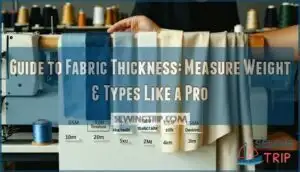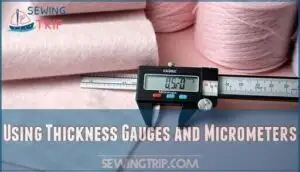This site is supported by our readers. We may earn a commission, at no cost to you, if you purchase through links.
 If you’re searching for a guide to fabric thickness, you’ll want to know more than just how a fabric feels between your fingers.
If you’re searching for a guide to fabric thickness, you’ll want to know more than just how a fabric feels between your fingers.
Thickness depends on fiber type, weave, and finishing, but pros use tools like micrometers and gauges for accuracy.
Weight, usually measured in GSM (grams per square meter), gives you a clear picture—think of it as the fabric’s “heft”.
Thicker fabrics often mean more durability and insulation, while lighter ones drape better.
Choosing the right thickness avoids sewing headaches like puckered seams or snapped needles.
Stick around for practical tips and tricks that’ll make fabric selection a breeze.
Table Of Contents
Key Takeaways
- You’ll use tools like micrometers, thickness gauges, and calipers to get accurate measurements instead of relying on touch alone—taking multiple readings across different fabric areas ensures consistency and accounts for natural variations in weave patterns.
- GSM (grams per square meter) tells you more about fabric weight and thickness than just feeling it—higher GSM typically means thicker, more durable fabric, while lower GSM indicates lighter materials with better drape.
- You’ll match fabric thickness to your project’s needs: lightweight fabrics (2.5-4 oz) work for delicate garments, medium weights (7-11 oz) suit formal wear, and heavyweight materials (11+ oz) provide structure for workwear and outerwear.
- You’ll avoid sewing problems by choosing the right thickness for your machine—thicker fabrics need heavier needles and adjusted tension settings, while lighter materials require gentler handling to prevent puckering or skipped stitches.
Fabric Thickness Basics
You’ll find that understanding fabric thickness is essential for selecting the right material, as it affects durability, comfort, and appearance.
Knowing how thickness is measured and what factors influence it helps you make informed choices for any project.
Unit of Thickness Measurement
When measuring fabric thickness, you’ll encounter two primary measurement systems: Metric vs. Imperial units.
The metric system uses millimeters and micrometers for precise fabric thickness measurement, where one millimeter equals 1,000 micrometers. Micrometers explained simply: they’re ideal for measuring delicate fabrics requiring extreme unit precision.
Imperial measurements use thousandths of an inch. Understanding millimeters conversion helps compare fabric thickness range across different manufacturers and practical applications.
Fabric weight, measured in GSM indicates thickness, is an important factor to consider.
Importance of Fabric Thickness
Fabric thickness information forms the backbone of smart textile choices, influencing everything from seasonal appropriateness to cost implications.
Understanding material thickness helps you predict durability and longevity while ensuring proper performance characteristics.
Thicker fabrics typically offer better insulation and structural integrity, while thinner materials provide breathability and drape.
This fabric thickness guide knowledge directly impacts your project’s aesthetic appeal and functionality.
Factors Affecting Fabric Thickness
Several key elements determine your fabric’s final thickness, creating variations even within the same material category.
Even within identical materials, multiple factors create surprising thickness variations that impact your project’s final outcome.
Understanding these factors helps you predict how different fabrics will perform in your projects.
Here are the 5 primary factors affecting fabric thickness:
- Fiber Density – Tightly packed fibers create thicker, more substantial materials than loosely arranged ones
- Weave Tightness – Close weaving patterns compress fibers together, reducing overall material thickness compared to open weaves
- Yarn Size – Thicker individual yarns naturally produce heavier, more substantial fabric structures
- Finishing Processes – Chemical treatments, brushing, and pressing can substantially alter final fabric thickness measurements
- Layering Impact – Multiple fabric layers or backing materials dramatically increase total material thickness during fabric thickness measurement
Measuring Fabric Thickness
Measuring fabric thickness accurately requires the right tools and proper technique to get reliable results.
You’ll need to prepare your samples correctly and use specialized instruments like thickness gauges or micrometers for precise measurements.
Tools for Measurement
Five essential tools deliver precise fabric thickness measurement results.
Digital precision gauges provide instant readouts, while micrometers offer superior accuracy through screw mechanisms.
Calipers handle delicate materials effectively.
Ultrasonic use enables non-contact measurement for challenging fabrics.
Laser applications support continuous production monitoring.
A fabric thickness gauge is vital for accurate readings.
| Tool Type | Accuracy Level | Best Application |
|---|---|---|
| Digital Thickness Gauge | High precision | General fabric measurement |
| Micrometer | Highest accuracy | Delicate, thin materials |
| Dial Thickness Gauge | Moderate precision | Quick field measurements |
| Ultrasonic Gauge | Variable precision | Non-contact requirements |
| Laser Gauge | Continuous monitoring | Production line measurement |
Gauge calibration guarantees reliable measurements across different anvil types and measurement techniques.
Preparing Fabric Samples
Start off by ironing out wrinkles—Wrinkle Removal is key for accurate fabric thickness measurement.
Cut your fabric sample square, ensuring Sample Stability. Condition each piece in a Controlled Environment to avoid skewed results.
Prepare Multiple Samples for reliability and use Consistent Labeling. These fabric sample preparation steps set the stage for using a thickness gauge, micrometer, or caliper with confidence.
Using Thickness Gauges and Micrometers
Once your sample’s prepared, place it between the thickness gauge or micrometer’s anvils.
Apply gentle, consistent anvil pressure to avoid compressing soft fabrics. Take multiple readings across different sample placement points since fabric thickness varies.
Proper gauge calibration guarantees accurate measurements. Record all reading variations carefully, as delicate materials show greater measurement differences than sturdy textiles, requiring attention to proper gauge.
Fabric Weight Matters
You’ll encounter fabric weight measurements like GSM everywhere in the textile world, but understanding what these numbers actually mean transforms how you select materials.
GSM directly relates to fabric thickness and determines everything from garment durability to seasonal appropriateness.
What is GSM
GSM Definition represents grams per square meter, the standard textile measurement for fabric weight measurement.
This metric indicates fabric density by measuring how many grams one square meter of material weighs.
GSM Significance lies in its universal application across the textile industry for comparing different fabrics.
Higher GSM values typically correlate with thicker, more durable materials, though GSM vs Thickness isn’t always directly proportional due to varying fiber densities and weave structures.
Fabric weight impacts breathability and drape, influencing garment suitability, as seen in the link to breathability and drape, which is crucial for garment suitability and understanding the importance of fabric weight.
Calculating GSM
You’ll calculate GSM using a straightforward GSM formula: divide fabric weight by sample area.
Cut a precise 10cm x 10cm square, weigh it in grams, then multiply by 100.
This measurement method determines fiber density accurately.
Higher GSM indicates heavier fabric weight and increased fabric cost.
GSM calculator tools can simplify this process.
GSM measurement serves various GSM applications, from determining fabric thickness to evaluating material quality for specific projects.
Converting GSM to OZ
Converting between GSM and ounces doesn’t require mathematical wizardry—just a reliable conversion formula.
You’ll multiply GSM by 0.0295 to get ounces per square yard, or divide ounces by 0.0295 for GSM measurement. Convert GSM OZ products are available online.
Here’s your conversion toolkit:
- Quick reference: 200 GSM equals approximately 5.9 ounces
- Online converters: Save time with digital fabric weight calculators
- Practical examples: Cotton t-shirts typically measure 160-220 GSM (4.7-6.5 oz)
Choosing Right Fabric Weight
You’ll discover that selecting the right fabric weight transforms your sewing projects from amateur attempts into professional-quality results that last.
Understanding how different weights affect your machine’s performance and final garment appearance saves you countless hours of frustration and wasted material, which is a complete concept that can help you achieve professional-quality results.
Factors Influencing Fabric Weight
Several interconnected elements shape fabric weight beyond basic material choice.
Fiber Density plays a major role – denser fibers like wool create heavier fabrics than cotton at similar thickness levels.
Weave Tightness affects weight substantially; tightly woven fabrics pack more yarns per square inch, increasing overall mass.
Yarn Size matters too – thicker yarns naturally produce heavier fabric construction.
Finishing Processes like coating or sizing add weight, while Moisture Content can temporarily alter measurements.
Understanding these fabric properties helps you predict how fabric blends will perform in your projects, considering factors like Fiber Density and Weave Tightness.
Fabric Weight Guide
Understanding fabric weight categorization helps you select materials that match your project’s demands.
Very lightweight fabrics (2.5-4 oz/160-220 GSM) work for delicate garments, while lightweight options (4-7 oz) suit summer clothing.
Medium weight fabrics (7-11 oz) balance durability and comfort for formal wear.
Heavyweight materials (11-14 oz) provide structure for workwear, and very heavy fabrics (14+ oz) offer maximum durability for outerwear applications.
Fabric weight is influenced by thread thickness and density.
Impact on Sewing Process
Fabric thickness directly affects your sewing success.
Thicker fabrics require heavier needles, adjusted thread tension, and wider seam allowances for clean results.
Your machine settings must accommodate fabric feed variations – lightweight materials need gentle handling while heavyweight fabrics demand stronger pressure.
Needle selection becomes critical as mismatched needles cause skipped stitches or fabric damage, and proper machine settings guarantee professional-quality seams across all fabric weights.
Fabric Thickness Measurement Techniques
You’ll need reliable methods to accurately measure fabric thickness for your projects.
These three essential techniques—the flatness test, caliper test, and fabric gauge—provide different levels of precision to help you determine the exact thickness of any fabric.
Flatness Test
A good flatness test starts with a simple Visual Assessment.
Lay your fabric on a smooth surface and check for Edge Curling or raised areas—thicker fabrics usually sit higher, while thinner ones lie flat.
Notice the Drape Quality and Wrinkle Resistance; stable fabrics resist curling and wrinkles.
This quick test helps you estimate fabric thickness before using a fabric gauge or thickness gauge.
Caliper Test
When the flatness test provides basic insights, calipers offer precise measurements for fabric thickness evaluation.
You’ll position your fabric sample between the caliper’s jaws, applying consistent anvil pressure for accurate readings.
- Caliper calibration guarantees measurement accuracy before testing begins
- Digital calipers provide instant readouts with enhanced precision capabilities
- Manual calipers require visual reading but offer reliable thickness measurements
- Test precision improves when you take multiple readings across different fabric areas
- Micrometer alternatives work similarly but use screw mechanisms for delicate materials
Fabric Gauge
Moving from calipers, you’ll find a fabric gauge handy for quick thickness measurement.
This tool uses notches to check fabric thickness, and Notch Accuracy matters for precise results.
Gauge Calibration guarantees you’re not measuring off-kilter.
Digital Gauges offer clear readouts, while traditional Gauge Materials like metal or plastic work well.
Gauge Alternatives exist, but always follow fabric thickness guidelines and use proper fabric thickness terminology.
Selecting Right Fabric Type
When choosing the right fabric type, you’ll need to examine weave structure, fiber content, and intended use to match performance with your project’s requirements.
Each fabric type—whether natural or synthetic—offers unique properties in durability, breathability, and appearance, so understanding these differences guarantees your selection meets both functional and aesthetic needs.
Fabric Weave Types
When you’re picking woven fabrics or knit fabrics, understanding fabric weave types makes all the difference.
Each weave pattern affects fabric thickness, weave durability, and weave texture.
Here’s what to look for:
- Plain weave—strong, simple, versatile
- Twill weave—diagonal ribs, good drape
- Satin weave—smooth, shiny surface
- Oxford weave—soft, casual
- Herringbone weave—distinctive zigzag pattern
The weave’s structure influences breathability and drape of the fabric, which is crucial for understanding fabric properties.
Natural and Synthetic Fibers
When you’re choosing between natural and synthetic fibers, you’re basically picking different fiber properties and characteristics.
Natural fibres like cotton, wool, silk, and linen offer breathability and biodegradability, while synthetic fibres such as polyester and nylon provide superior fiber durability and moisture-wicking capabilities.
Blended fabrics combine both worlds, mixing natural comfort with synthetic strength.
This fiber composition directly impacts fabric thickness and overall fabric characteristics, making sustainable fibers increasingly popular for various fabric types and fiber applications.
Fabric Applications
When you consider fabric applications, your project’s demands should drive fabric choices.
Clothing requires comfort and durability, while activewear fabrics need moisture-wicking properties for gym performance.
Workwear materials prioritize strength and weather resistance.
Climate considerations matter too—lightweight fabrics suit warm weather, heavyweight options work for cold conditions.
Luxury garments demand fine textures and drape.
Use your thickness gauge to verify fabric specifications match application requirements.
Different projects may even call for specialized fabric materials like leather or lace, which can be crucial for the project’s success.
Practical Considerations
You’ll need to examine several practical factors when measuring fabric thickness in order to achieve accurate, reliable results.
Understanding these considerations helps you avoid common measurement errors and select appropriate techniques for different fabric types.
Different Measurement Units
You’ll encounter fabric thickness in metric and imperial systems.
Metric uses millimeters or micrometers for precision, while imperial uses inches. Converting between systems requires specific formulas—one millimeter equals 0.0394 inches.
Standard units guarantee consistency across manufacturers. Use digital calipers for measurement precision in either system.
Understanding both systems helps when working with international suppliers or patterns requiring different measurement units, ensuring consistency and facilitating work with international suppliers.
Impact of Fabric Composition
Fabric composition directly affects thickness measurements through varying fiber densities and manufacturing processes.
**Fiber density and weave patterns dramatically influence your thickness readings—choose your measurement spots wisely.
Different materials compress differently under measurement pressure, potentially skewing your readings if you don’t account for these variations.
- Fiber properties: Cotton fibers create different thickness patterns than synthetic materials like polyester due to natural irregularities
- Blend advantages: Mixed compositions combine fiber characteristics, requiring multiple measurement points for accurate assessment
- Synthetic impact: Man-made fibers often maintain consistent thickness but may compress more under gauge pressure
- Weave density: Tighter fabric structure increases thickness regardless of individual fiber weight, affecting overall measurements
Understanding fabric structure helps you anticipate measurement challenges and select appropriate tools for different material types.
Importance of Averaging Measurements
Taking multiple measurements across different fabric areas helps you achieve accurate thickness readings.
Fabric thickness naturally varies due to weave patterns, thread density, and manufacturing irregularities.
Single measurements can mislead you, while averaging five to ten readings will reduce variability and minimize errors.
This approach accounts for natural inconsistencies, providing consistent data that reflects the fabric’s true characteristics for reliable decision-making.
Choosing Representative Fabric Sample
Choose samples from different fabric areas to avoid misleading measurements.
Sample Size matters—cut multiple pieces from various locations across your material.
This approach guarantees Bias Reduction by capturing thickness variations throughout the fabric.
Fabric Stability improves when you select unwrinkled, flat sections.
Wrinkle Prevention starts with proper fabric handling before cutting.
Consistent Preparation means using identical cutting methods for each sample.
Multiple measurements from representative samples deliver accurate measurements that reflect true fabric thickness characteristics, ensuring Fabric Stability and Wrinkle Prevention through Consistent Preparation.
Considering Fabric Bias
When measuring fabric thickness, you must account for grain alignment and bias stretching effects.
Bias Impact varies substantially because fabric direction affects drape properties and measurement accuracy.
Cutting techniques matter since bias stretching can alter readings by up to 20%.
Understanding how true bias cuts behave is essential for accurate measurements.
Always measure along the grain for consistent fabric thickness measurement results.
Frequently Asked Questions (FAQs)
How to determine fabric thickness?
Like examining a fabric’s shadow cast against light, you’ll use calipers, thickness gauges, or micrometers to measure between the fabric’s surfaces.
Take multiple readings across different areas for accuracy and consistency.
What does 12oz fabric mean?
A 12oz fabric weighs 12 ounces per square yard, categorizing it as heavyweight material.
You’ll find this weight provides excellent durability and structure, making it perfect for jeans, workwear, and sturdy garments requiring longevity.
Is 260 GSM fabric good or bad?
Consider a heavy winter hoodie – that’s roughly 260 GSM fabric.
This weight sits in the medium-to-heavyweight category, offering excellent durability and warmth.
You’ll find it’s quite substantial, perfect for structured garments and cooler weather applications, making it a great choice for durability.
Is 8oz fabric thick?
8oz fabric sits in the medium-weight category, making it moderately thick.
You’ll find it balances durability with comfort—perfect for trousers, formal shirts, and structured garments that need substance without being heavy.
How does fabric thickness affect garment durability?
Thicker fabrics boost durability since they resist tears, abrasions, and general wear better than lighter ones.
If you want a shirt that withstands frequent use or rough handling, opt for something heavier—your laundry routine will thank you, as it improves overall durability.
Can thick fabrics be used for summer clothing?
Yes, you can wear thick fabrics in summer—it’s not swimming upstream against nature’s current.
Certain heavyweight materials like linen or loose-weave cotton allow excellent airflow despite their thickness.
The weave structure and fiber breathability matter more than weight alone for comfort, and understanding this concept is key to staying cool in thick fabrics.
Does fabric thickness change after washing and drying?
Fabric thickness typically decreases after washing and drying due to fiber relaxation, shrinkage, and mechanical compression from the washing process.
You’ll notice this change most in natural fibers like cotton and wool.
Which fabrics maintain thickness best over time?
Natural fibers like wool and linen maintain thickness better than cotton blends.
Heavyweight fabrics resist compression more effectively than lightweight ones.
Synthetic blends with polyester help preserve dimensional stability through multiple wash cycles.
How does thread count relate to thickness?
Thread count doesn’t directly determine thickness – you’ll find high thread count fabrics can still be thin if they use fine threads.
While lower counts with thicker yarns create heavier fabrics.
Conclusion
Mastering this guide to fabric thickness transforms you from a guessing seamstress into a precision craftsperson.
Like a conductor reading musical notes, you’ll now interpret GSM measurements, thickness gauges, and fabric weights with confidence.
Whether you’re selecting canvas for upholstery or chiffon for evening wear, these measurement techniques guarantee perfect project outcomes.
Remember to test samples, average multiple readings, and consider fiber composition.
Your sewing machine—and your finished projects—will thank you for this newfound expertise in fabric selection.
- https://shbamovement.com/blogs/news/how-clothing-thickness-is-measured-a-deep-dive-into-gsm
- https://propercloth.com/reference/fabric-thickness-weight/
- https://www.hans-schmidt.com/en/produkt-details/thickness-gauge-d-1000/
- https://corefabricstore.com/blogs/tips-and-resources/fabric-weights-blog
- https://sino-silk.com/fabric-weight-guide/
















